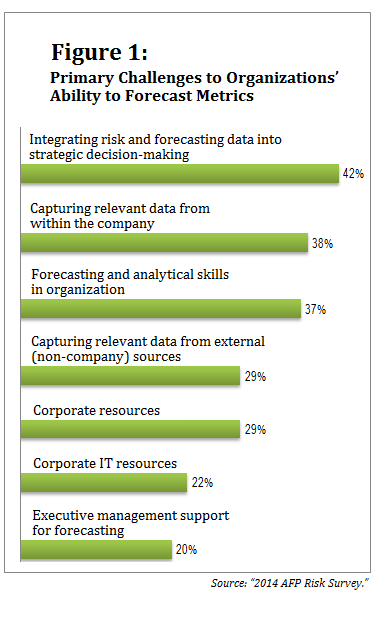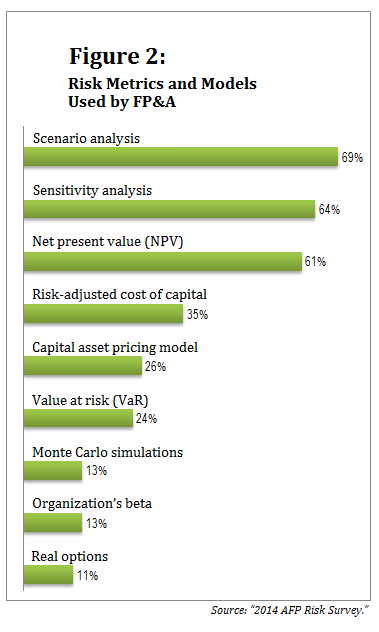Today, the Association for Financial Professionals (AFP)released the results of its “2014 AFP Risk Survey,”sponsored by Oliver Wyman. The survey of 554 AFP members revealedthat although organizations expect the global business environmentto remain challenging this year, finance executives are now morefocused on internal issues than on the macroeconomic climate.
|The external environment continues to cause concern: Forty-fivepercent of respondents said their company is exposed to moreearnings uncertainty today than it experienced three years ago, andonly 16 percent said they're now operating with less uncertaintythan in 2010. The causes vary. Just over a quarter of respondents(26 percent) cited financial factors such as credit, liquidity,interest rate, and currency risks as the primary driver of theirearnings uncertainty. Almost as many (23 percent) citedbusiness/operational risks (e.g., supply-chain disruptions,litigation, IT), and another quarter selected external factors suchas regulatory and country risks. Only 19 percent reported thatmacroeconomic factors, such as GDP growth and inflation, are thekey driver of their earnings uncertainty.
|To manage their financials amid these uncertainties, companiesneed to accurately forecast their myriad risks—but that's easiersaid than done. For 35 percent of the companies represented in theAFP survey, forecasting risks is more difficult today than it wasthree years ago; risk forecasts are easier today for only 23percent of respondents. Almost a third of finance executives saidthat capturing relevant data from external sources causesforecasting challenges, but many more said it's challenging tocapture relevant data from within the company. (See Figure 1.)
|
For some companies, the problems start with a siloed approach tofinancial planning and analysis (FP&A). Less than half ofsurvey respondents (48 percent) said their FP&A team employsrisk analysis on a regular basis; 29 percent said FP&A staffuse risk analysis occasionally. The vast majority of FP&A teamsthat use risk analysis undertake scenario planning (69 percent ofall respondents), sensitivity analysis (64 percent), and netpresent value (NPV—61 percent). Lower proportions use otheranalytical methods such as risk-adjusted cost of capital, value atrisk (VaR), and Monte Carlo simulations (see Figure 2). More than athird of respondents think their strategic planning activitieswould benefit from more risk-adjusted analysis.
|
Only one in five (21 percent) reported a high degree ofcollaboration between their FP&A and risk management teams,while slightly more than half (53 percent) reported a moderatelevel of collaboration. Sixty-one percent of these respondents saidthat improving coordination between the FP&A and riskmanagement functions leads to better forecasting because itimproves the quality of finance and risk inputs from business unitscompanywide. Fifty-seven percent said bringing the functionstogether improves the consistency of business and marketassumptions, and for 56 percent it improves the consistency of dataused for risk and FP&A analysis.
|Perhaps that's why almost two-thirds of organizations haveresponded to current and emerging business risks by increasingtheir focus on risk culture and risk awareness. Other responsesinclude growing the company's product lines (58 percent ofrespondents), expanding geographically (48 percent), increasingcapital expenditures (46 percent), hiring external resources (44percent), and accelerating merger and acquisition (M&A)activity. (See Figure 3.)
|
Complete your profile to continue reading and get FREE access to Treasury & Risk, part of your ALM digital membership.
Your access to unlimited Treasury & Risk content isn’t changing.
Once you are an ALM digital member, you’ll receive:
- Critical Treasury & Risk information including in-depth analysis of treasury and finance best practices, case studies with corporate innovators, informative newsletters, educational webcasts and videos, and resources from industry leaders.
- Exclusive discounts on ALM and Treasury & Risk events.
- Access to other award-winning ALM websites including PropertyCasualty360.com and Law.com.
*May exclude premium content
Already have an account? Sign In
© 2024 ALM Global, LLC, All Rights Reserved. Request academic re-use from www.copyright.com. All other uses, submit a request to [email protected]. For more information visit Asset & Logo Licensing.






